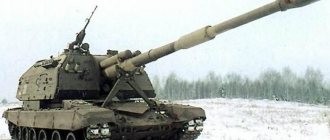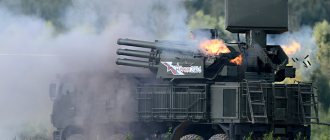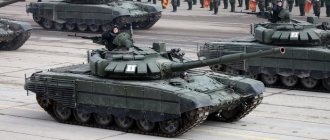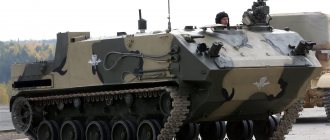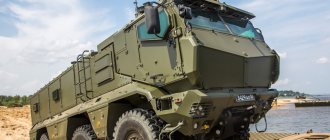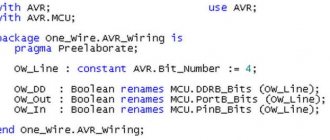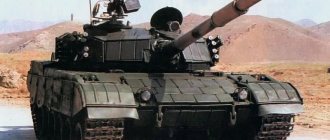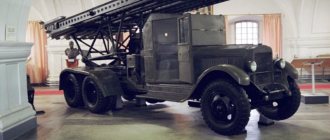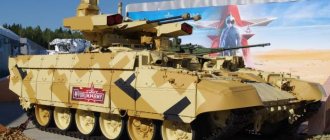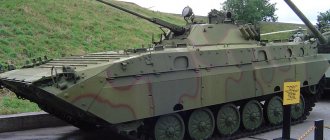Despite the increased role of aviation in military conflicts, which we have seen over the past decades, artillery remains a very important factor, very often deciding the outcome of military operations. This is especially true for self-propelled artillery units; they truly justify the title of “god of war.”
Currently, in many countries around the world, work is underway to create new self-propelled artillery units (SPGs) and modernize old ones. Another popular area is the development of new types of ammunition, the creation of guided projectiles, and increasing their power and firing range. Progress in the development of loading systems, increased accuracy and mobility make self-propelled guns a very effective tool that can solve many problems.
A self-propelled artillery mount is a weapon (often of large caliber) mounted on a tracked or wheeled chassis, used in direct support of infantry and armored vehicles.
History of creation
This artillery installation has an interesting history. In 1980, they began to develop a fundamentally new artillery system. The resulting sample was called "Msta-S". She was supposed to replace her predecessor, the Akatsiya self-propelled gun.
In 1983, an experimental machine was created, ready for testing. The T-72 tank became the basis for the self-propelled gun. However, this was the wrong decision, as tests showed. The main drawback is that the gun swayed strongly during firing. Then they decided to use the T-80 as the basis. And this helped close the problem.
In 1986, State tests began. They were very successful. The self-propelled gun passed all test tasks. In 1989, Msta began to be supplied to the army. And in 1986, the 2A65 Msta-B self-propelled gun entered the army; this is a variant using a tug.
A total of 1,200 towed howitzers of this type were created, and they are still in service in some CIS countries today.
There were also design solutions on wheels. This significantly increases the maneuverability of the machine. Even before the creation of the main self-propelled gun "Msta", a self-propelled wheeled howitzer was created on the basis of the KrAZ-6316 vehicle.
But its tests made it clear that this type of weapon has too many shortcomings to continue testing. Subsequently, adjustments and improvements were made to the design of the self-propelled gun, taking into account real combat use:
- Taking into account the experience of combat operations, primarily in the Caucasus, some improvements were made and automatic equipment was installed that controls the fire.
- To adjust shooting in 2002, special software was developed.
The latest development of Soviet designers is the 2S19 152 mm howitzer. It became the main artillery system for a long time. 2012 was the time of the last modernization of the self-propelled gun.
Fire control has been further improved; the rate of fire has been increased to 10 rounds per minute.
Design
The artillery system body is welded, made of hot-rolled sheets 15 mm thick. The body has three compartments: controls with the driver in front, a fighting compartment in the middle, and a power compartment (internal combustion engine, transmission, etc.). There is a turret with the actual gun. The weight of the tower is 13.5 tons. The turret houses the commander, gunner and loaders. The conveyor with charges and shells is placed at the stern, and there is also a tray for receiving shells from the ground.
Armament of self-propelled guns. The 2A64 152 mm howitzer is the main weapon of this self-propelled gun. In addition to the barrel, the main components of the howitzer include the bolt, rammer, cradle, recoil devices, lifting and balancing mechanism. A shot is fired using an electric trigger; if it fails, you can do it manually.
The barrel is raised using automation, or using a mechanical device in case of failure of this automation.
Standard ammunition - 50 shots. Among them may be the Krasnopol, a 152 mm guided projectile. But still the basis: active-reactive, high-explosive fragmentation lighting shells.
The Msta-S is adapted to fire both nuclear and tactical shells.
The NSVT 12.7 mm machine gun is mounted on the turret. It is capable of hitting low-flying targets. The ammunition set includes, in addition to the standard quantity: 900 cartridges for machine guns, 300 cartridges for a machine gun and 20 F-1 grenades.
On the main turret, above the commander's position, there is a small cupola, like the T-64 or T-80. To successfully conduct reconnaissance and surveillance, the commander has a TKN-3V sight installed.
With its help you can aim the main weapon. Sight PZU-5 for a machine gun. The gunner has a 1P22 panoramic sight. Sight 1P23 for direct fire. TNPO-160 prism observation devices, there are three of them in total and all of them are kept by the mechanic. The standard equipment also includes TVNE-4B - a night vision device.
For external communications, the radio station R-173 is used, its range of action is 20 km. The 1B116 device provides internal communication.
The self-propelled gun has a V-84A engine with a power of 780 hp. With.
This is a diesel engine with 12 cylinders, four-stroke, V-shaped, supercharged. Liquid cooling. The engine runs on diesel fuel, however, kerosene (T-1, TS-1 and T-2) can also be used as an alternative fuel.
The transmission in the self-propelled gun is two-flow, mechanical. The rotation mechanism is planetary. There are seven forward gears, one reverse gear. The self-propelled gun reaches speeds of up to 60 km/h.
Chassis like the T-80 (6 pairs of rubber-coated support rollers and 5 pairs of support rollers). Drive wheels at the rear, guide wheels at the front. The 2S19 uses a custom torsion bar suspension. The shock absorbers are hydropneumatic, but not on all rollers, but only on the 1st, 2nd and 6th support rollers.
Howitzer guidance
The effectiveness of the gunner's work is determined by the use of specific sights and guidance drives. The self-propelled howitzer we are considering uses two sights: a rotating panoramic 1P22 (3.7 times magnification) and a fixed direct fire 1P23 (5.5 times magnification). A special feature of the panoramic sight is its more complex structure (using derotational optics and a gyroscope), as well as the ability to rotate it 360, which is an important feature of modern tanks and self-propelled guns.
The guidance drives are extremely ergonomic for the gunner, which is important in a combat situation. Particularly practical is that the vertical drive always does its job automatically. An additional convenience is the elevation angle that is automatically restored after each shot.
Thus, the crew is left to adjust the control device for the horizontal drives so as to align the sight and the aiming point. This is the meaning of the work of the 2S19 MSTA-S gunner. The photo, by the way, demonstrates this; indeed, his gaze practically does not leave the sight at handles, levers, etc. This really contributes to the effectiveness of the battle.
Performance characteristics in comparison with analogues
Technical characteristics look most impressive when compared with foreign analogues.
| TTX | "Msta-S" | AS-90 | M109Palladin | PLZ05 | Type99 | K9Thunder | PzH2000 |
| Weight, t | 42 | 45 | 23 | 35 | 40 | 47 | 55 |
| Speed, km/h | 60 | 55 | 67 | 55 | 50 | 67 | 67 |
| Length with barrel, mm | 11917 | 9900 | 6614 | 11600 | 11300 | 12000 | 11670 |
| Width, mm | 3380 | 3400 | 3150 | 3380 | 3200 | 3400 | 3480 |
| Height, mm | 3350 | 3000 | 3280 | 3550 | 4300 | 2730 | 3400 |
| Caliber, mm | 152 | 155 | 155 | 155 | 155 | 155 | 155 |
| Ammo quantity | 50 | 48 | 28 | 30 | 30 | 40 | 60 |
| Firing range, km | 29 | 24 | 22 | 40 | 30 | 56 | 50 |
| Crew, people | 5 | 4-5 | 6 | 4 | 4 | 5 | 5 |
| Engine Power, hp | 780 | 660 | 675 | 520 | 600 | 1000 | 1000 |
As you can see from the table, “Msta-S” looks, in any case, no worse than foreign models.
Vehicles based on Msta-S and modifications
There are not many modifications to the artillery mount. SAU 2S33 “Msta-SM”, the most successful of them. This car was designed to meet and exceed Western standards. The system has improved guidance control.
But besides this modification, there are several copies that remained at the test stage, although they had good prospects for being put into mass production:
- "Msta-K" 2S21 wheeled version. In this case, we limited ourselves to a prototype. But he had many shortcomings. Work was suspended, and the wheeled self-propelled gun was not destined to enter the army. Although this type of self-propelled guns has prospects, since the maneuverability of this heavy artillery system increases.
- 1K17 “Compression”. In 1992, one experimental version was created, based on the 2S19 self-propelled gun. But the collapse of the Soviet Union did not allow the production of this unique installation, designed to disable the optical-electronic guidance systems of enemy military equipment, to be launched.
Both variants of self-propelled guns were not developed, although they had good prospects. The Russian Army currently uses a modernized 2S19M2 self-propelled gun.
Conclusion
Considering the evolution of the 2S19M self-propelled gun, we can conclude that there has been a radical change in combat tactics. Innovative fire control systems are beginning to gain relevance. Automation is literally starting to fight. An artillery mount with a fire control system is becoming a weapon of the future. This is starting to resemble science fiction movie wars. The on-board computer of the self-propelled gun has the ability to instantly assess where enemy firing points are located and provide the sighting device with the necessary information to suppress them with fire. The functions of the gunner begin to resemble the dispatch duties of a PC user sitting at the monitor.
It is characteristic that this process is being improved towards the combat dominance of automated systems over the human factor.
Use in combat
This installation received its baptism of fire in several local conflicts of the last two decades.
The use of an artillery mount during the Chechen wars, both the first and the second, showed positive aspects - high maneuverability and shooting accuracy, but negative aspects were also discovered; subsequent improvements led to the creation of a modernized version 2S19.
During the Ethiopian-Eritrean war 1998 - 2000. The Ethiopian side very effectively used the systems to defeat enemy forces at long ranges.
During the conflict in South Ossetia in 2008, 70 self-propelled guns were part of the 58th Army.
Ukraine 2014 – 2015, conflict in the southeast of the country during which Ukrainian troops sometimes used Msta-S self-propelled guns during combat operations.
Self-propelled turret
For structural reasons, this element of the self-propelled gun is much more massive than that of a tank. Of course, this is explained by the caliber and power of the howitzer. Suffice it to recall that the upper plane of the tower is almost three meters high from ground level. The self-propelled unit is powered by 4 rechargeable batteries with a voltage of 27 V each. A 2A64 howitzer is mounted in the turret, covered with rolled armored sheets, and there are also sighting systems, automatic ammunition supply, filter ventilation, and a combined communication system.
When the main engine is turned off, the power supply for the on-board equipment is provided by the AP-18D unit. It also charges the batteries and starts the engine. In general, as we see, the 2S19 MSTA-S turret is a rather complex technical complex, protected by armor sufficient for a “second-line” weapon. Its weight is 13.5 tons.
Interesting facts or historical heritage
At the very first foreign shows, Msta demonstrated its unique capabilities. At an arms exhibition held in 1993 in Abu Dhabi, at a distance of 15 km, this installation hit 38 out of 40 targets.
Today, Msta-S is the main self-propelled system of the Russian army. But the firing range of these self-propelled howitzers does not meet modern requirements. Therefore, prototypes of the 2S35 “Coalition-SV” have already been developed and created, which should replace the “Msta-S” by approximately 2022.
Self-propelled gun gun. Supply of shells
A rifled gun - a 152 mm caliber howitzer of the self-propelled gun we are considering - uses not only an ammunition load consisting of 50 shells and 300 machine-gun cartridges located directly in the turret, but is also capable of firing through the robotic supply of various projectiles brought to the self-propelled gun, i.e. "from the ground."
The automatic reloading system rhythmically delivers shells to the gun, regardless of the angle of the howitzer barrel and the degree to which the installation itself returns to the MSTA loading line. The self-propelled howitzer is equipped with a semi-automatic two-conveyor projectile supply system. Each conveyor is serviced by a separate loader. When firing from the ground, additional conveyors are used, which allows saving on-board ammunition. The firepower of the self-propelled gun and its versatility in a combat situation is largely determined by the following shells used (see Table 2).
Table 2. Shells for MTS-S ammunition
| Projectile brand | Projectile type | Firing range |
| 3OF45 | high explosive | 24.7 km |
| 3VOF72 | high explosive | 28.9 km |
| ARS 3OF61 | active - reactive | 28.9 km |
| 3VOF73 | high explosive | 28.9 km |
| 3VOF58 | high explosive | 28.9 km |
| 3HC3O | installation of r/l interference | 22.3 km |
| 3VDC8 | installation of smoke curtains | 22.3 km |
| 3OF39 | laser-guided "Krasnopol" | 25 km |
